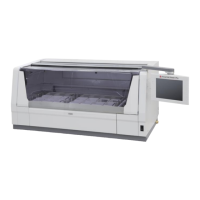Basics on This Instrument
This section explains the Basics of operating the instrument. For the details of each item, refer to the page
indicated in the text.
● This instrument automatically stains tissues and cell smear samples on glass slides for microscopy, as
part of histological studies and tests conducted in the fields of pathology, anatomy, clinical pathology,
etc.
The instrument supports various types of staining such as H&E, Papanicolaou etc.
● This instrument is operated from the touch-panel type display located on the right side. This display
allows the operator to easily operate the instrument according to visual cues by touching the necessary
keys displayed on the screen. Staining data can also be output from a PC by using a special compact
flash card (CF card).
● Two types of baskets can be used for storing slides: the 20-slide type for general staining and the 10-
slide type for special staining
● Solution reservoirs are largely classified into three types: standard solution reservoir, small solution
reservoir and special stain solution reservoir. The basket capacity and required solution volume of each
solution reservoir are summarized below.
Standard solution
reservoir
This instrument performs stain process in the "continuous mode" and "batch mode." The two staining
modes are explained below.
• Continuous mode
A different staining run can be started during the current staining run, with up to 11 staining runs
performed simultaneously.
• Batch mode
In this mode, each stain process must be completed before the next sample can be stained. The start
step and end step can be specified to start a staining run.
Refer to P. 1-33 on how to set each mode.
User Management by Password
The instrument can limit the operating functions permitted to each user according to the user’s password.
Two types of passwords are provided. The "Administrator Password" is a higher-level password that
permits all operations, while the "User Password" is a lower-level password that permits only the specific
operations pre-defined for each user. Refer to P. 1-39 for details on how to set a password, etc.

